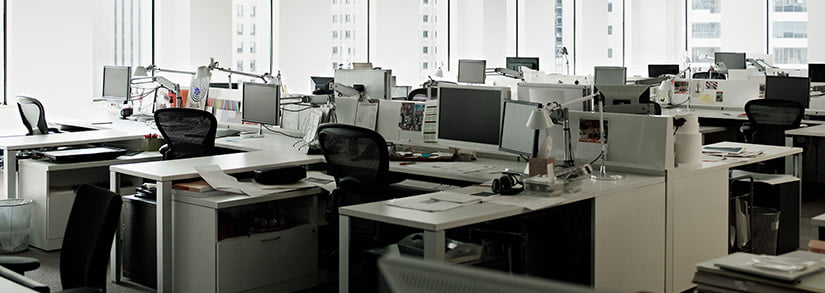
When Covid-19 happens, Space changes, businesses reduce density, focus more on increasing the area of interaction between employees due to more and more remote working. Here are 3 trends of the office rental market during the Covid-19 epidemic.
Grade A rents keep stable or decrease slightly During Covid-19

In Europe, when Covid-19 happens, most markets maintain stable office rents with a change of only about 2% a year. Some places recorded a decrease in rents such as Dublin (Ireland) down 12%, Cologne (Germany) down 8%, and Barcelona (Spain) down 4%.
In other cities such as Hamburg, Berlin, and Munich, high-end office rents recorded modest increases. Secondary rent here is forecasted to remain stable in the short term but will adjust if the landlord does not fully meet the needs of guests. In the future, rents are forecast to stabilize or decrease slightly by only about 1% before the blockade orders in a few major cities. In the short term, incentives for tenants will still be popular.
In Shanghai, most businesses have returned to normal. Developers are working hard to increase value for guests. When the supply is released more but the demand is not much, the rent and occupancy rate in Shanghai will tend to decrease. Currently, the percentage of landlords willing to offer flexible rental terms in this market is only 40%. Some commercial projects have been delayed in completion due to delayed construction, so the pre-lease period has been extended to 12-15 months.
In Hanoi, Grade A office rents are assessed to be stable in the coming year. With Capital Place entering the market and bringing in more than 90,000 sqm of leasable area in the inner city, Grade A supply increased 24% YoY and average rent increased 7% in the first half of 2021. Office buildings with a large area will need a long time to be filled. Therefore, Grade A rents are expected to remain stable due to the limited number of high-end projects until 2023.
Stable or increasing demand in specific industries
Office demand in Europe has been recorded to be stable year-on-year and the market shows a shift in demand from the technology sector to the manufacturing and pharmaceutical sectors. Last year, the rental demand of technology enterprises accounted for 21% of the total demand, but this proportion decreased to 14% in the first half of 2021. Meanwhile, the rental demand of manufacturing and pharmaceutical enterprises increased from 5 % in 2020 to 13% in 2021, of businesses in the real estate and construction industries also increased from 2% to 10% at the same time.
In Hanoi, in 2021, the information and communication technology, manufacturing, finance – banking – insurance industries are expected to grow. Rent is not a prerequisite that tenants care about in this market. Office leasing businesses now have more requirements for the location of their headquarters, the quality of building construction, the services provided, as well as the area that the building can meet for expansion needs in the future.
Office space changes when Covid-19 happens
The rollout of vaccination programs in Europe allows most businesses to return to the office. Accordingly, many businesses have redesigned their office space, with the orientation of prioritizing safety and health factors. In addition, with a large number of employees wanting to work more flexibly, some companies have reduced the office space. Many other companies adopt a ‘hub and spoke’ model, combining a centrally located headquarters and flexible office spaces near residential areas. In general, most expect employees to be able to spend a certain amount of time working in the office so that they can ensure internal interactions, maintain corporate culture as well as meet customers.
In Hanoi, the trend of office use has seen many changes, businesses focus more on increasing the interaction area between employees and at the same time recalculating the actual working area.
Previously, most of the Grade B and C office buildings in both Hanoi had a fairly thick staff density. However, when employees work from home more, it is necessary to adjust the density to suit the actual user needs. A company with 100 employees will only need to arrange a workplace for 60-70 people and everyone can flexibly work from home or go to the office. With the remaining area, the company can integrate many other utilities and functions such as dining areas, resting areas for employees or even adding more meeting rooms. This is also one of the factors that make companies change more about working models.
In Shanghai, with demand at a stable level, most corporate tenants expect the lease terms to remain unchanged. Notably, some developers also provide temporary working areas for tenants and at the same time upgrade the operation management service of the building, focusing on investing in Proptech technology solutions, such as touch elevators or facial recognition security gates.
For Foreign companies that want to start or expand businesses and look for an office in Vietnam:
CONTACT US
We offer a free consultation to support you to find a suitable Office For lease In Ho Chi Minh:
Phone: (+84) 398 716 459 – Available via Whatsapp/ Viber/ Zalo
Email: contact@lookoffice.vn
Website: https://lookoffice.vn/contact
Facebook: https://www.facebook.com/lookoffice.vn/
Office For Lease at LOOKOFFICE
source https://lookoffice.vn/3-trends-of-the-office-for-rent-market-during-covid-19
Read Vietnam Economy Weekly News

No comments:
Post a Comment